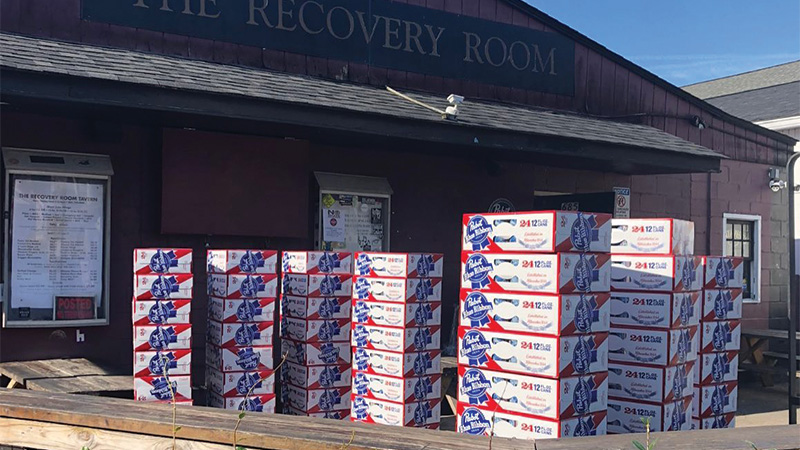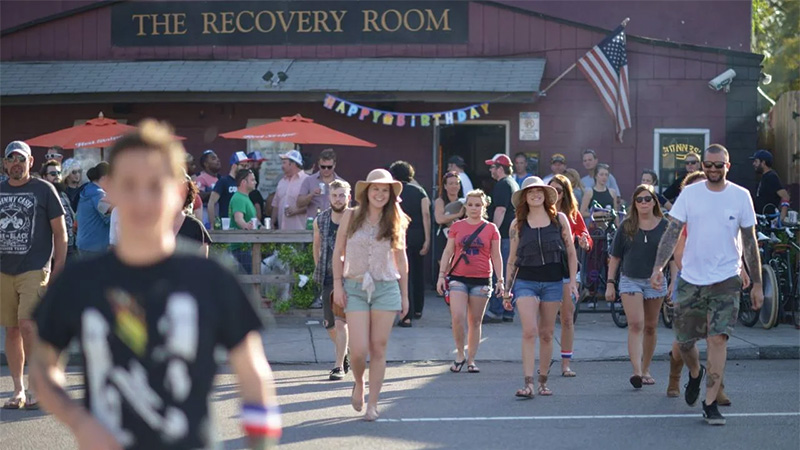If today Charleston is one of the top tourism destinations in America, beloved for its James Beard Award-winning restaurants like Husk and chefs like BBQ master Rodney Scott, and well known for its drink scene that includes top breweries and distilleries, iconic cocktail bars like The Living Room, and wine bars like Stems & Skins (owned by VinePair’s Wine Professional of the Year, Matt Tunstall), things were quite a bit different back in the late aughts.
Back then, the city of 115,000 did not yet have a “proper” craft cocktail bar (The Gin Joint would arrive in 2010). There was a bit of a craft beer scene, bolstered by Scott Shor’s Charleston Beer Exchange, which opened in 2008, but the “Holy City” still only had a handful of breweries. Craft distilleries wouldn’t come until 2013 courtesy of Striped Pig and High Wire Distilling Company. Most locals still did their better drinking at restaurants.
Enter Chris “Boston” DiMattia who had moved from Massachusetts to the area in 1998 to attend the College of Charleston. “The bars that were popular at the time were, like, kind of the divey food and ‘bev’ kind of late-night bars,” he recalls. “People who just wanted a beer and a shot, pitchers of beer, that sort of thing. That was the scene.”
Don’t Miss A Drop
Get the latest in beer, wine, and cocktail culture sent straight to your inbox.
Eventually looking to start his own place, he found a private club, north of downtown, right next to a highway off-ramp, on “the last sort of commercial building on King Street before it really becomes residential.” The landlord claimed all the former customers of the bar had either moved out of the city as gentrification loomed, or had gotten too old for the club scene. DiMattia took over the spot and launched the Recovery Room in 2008.
Now he just needed to get his own customers.
DiMattia set up an enormous garbage can behind the bar counter and filled it with ice and cans of Pabst Blue Ribbon (PBR). A decade and a half later, DiMattia is inarguably the greatest seller of the beer in the entire world.
The Rise of PBR
PBR had fallen on hard times in 2001, which saw a 90 percent sales slump compared to a 1975 peak. But then in 2002, sales of the economical, old-man lager seemed to magically rise. The year after, they started to boom.
What had happened?
“The most interesting theory is that PBR’s fan base grew not despite the lack of marketing support, but because of it.”
If anything, to an outsider, it would have looked like the brand was about to go defunct. Pabst had shut down its actual breweries and contracted its beer-making to the Miller Brewing Company.
PBR, which rarely advertised over the years, began to nominally sponsor bike messengers — that most archetypical of the big-city hipster — in the Pacific Northwest, most notably in Portland, Ore., where trendy types had already embraced the brand. It soon become de rigueur in other urban enclaves like lower Manhattan and the Mission District of San Francisco.
But supporting bike messengers and tossing a thousand bucks at their street parties surely wasn’t making this beer trend across the country. In fact, even PBR execs were confused about what was going on.
“The most interesting theory is that PBR’s fan base grew not despite the lack of marketing support, but because of it,” The New York Times Magazine wrote in 2003.
Neal Stewart, a 20-something marketing manager at Pabst, began to visit hipster hangouts and bike messenger bars to see what was occurring. He quickly learned that these were the sorts of people who detested being marketed to. To bluntly advertise to them would ruin everything. And so he didn’t bother them.
Stewart turned down his higher-ups when they suggested buying ads on alt-rock stations. He refused to sponsor a snowboarding team or any other X-Games sports. He even denied Kid Rock when he came looking to be a product endorser.
The beer was cool, the beer was retro, the beer was blue collar, and the beer was cheap — as little as a buck a can in some Portland bars, just as craft beer was having a renaissance and prices were beginning to soar.
Most importantly, perhaps, as cited in Robert Lanham’s “The Hipster Handbook” from 2003, PBR was “the one beer that is cool to drink out of a can.”
The Rise of the Rec
DiMattia recalls first drinking cans of PBR before it was trendy, back when he was at the College of Charleston. He wasn’t a hipster or a bike messenger; he was a college kid and 12-packs were dirt cheap. At Charleston bars in the early aughts, a PBR cost around $2 a can.
When he started working at bars like Moe’s Crosstown after college, he noticed most everyone in hospitality ordered the beer after their shift. “I really wouldn’t make a whole lot of money bartending until like 11:30 at night when all these food and bev people would come in and be like, ‘Give me a PBR and a shot,’” he recalls. “Their tabs would be $25 but they’d leave a $15 tip.”
“I was trying to build regulars, so it was more about not running out, knowing that they could come in at 1:40 in the morning and still get a beer and shot that is affordable.”
So, when DiMattia opened Recovery Room, he knew that he not only needed to stock PBR, but he needed to make sure he never ran out of it.
Enter that garbage can filled with ice cold cans.
“A lot of places want to do a cheap beer special and you go in after four cases have sold and they’re like ‘Oh, we’re out. Try this beer instead,’” DiMattia says. “I was trying to build regulars, so it was more about not running out, knowing that they could come in at 1:40 in the morning and still get a beer and shot that is affordable.”

By the end of aughts, the stereotype that hipsters love PBR had become a now-incorrect, out-of-touch joke; everyone was drinking it, from college kids to lawyers, doctors, architects, celebrity chefs, and a host of blue collar workers just finishing shifts, according to DiMattia. PBR volume sales increased by 69 percent from 2005 to 2010. Many hipsters by this time had, in fact, moved onto Miller High Life.
In 2010, Pabst sold for a reported $250 million. Then, the next year, a PBR sales rep from Atlanta, Jay Toxey, happened to mention to DiMattia that the Rec Room was selling the second most 12-ounce cans of any spot in America, right after a billiards bar in Manhattan called the Fat Cat. In 2012, the New York University-area hot spot only beat Rec Room by a mere 39 cases.
By 2013, Rec Room had begun to get press for this feat, even if the bar hadn’t quite ascended to the throne. How (and why) the humble Recovery Room became the nation’s No. 2 PBR seller, wrote the Charleston City Paper. (“It’s a windowless hovel on Upper King Street with pinball, pool, and foosball, its walls decorated according to no particular theme and its restrooms bedecked in vulgar latrinalia.”)
By 2013 DiMattia was selling PBR cans for $2, or $1.25 during happy hour, and they were accounting for 25 to 30 percent of his bar’s overall sales. That year, the Rec Room also happened to be Charleston’s No. 1 seller of Yuengling.
Then, in 2014, Rec Room finally took the PBR title, and it hasn’t lost it since.
As Toxey, who calls DiMattia the P.T. Barnum of dive bars, said, “Y’all drink a shit-ton of PBR in Charleston.”
Nine Years in a Row
By 2019, the Recovery Room was selling around 140 cases of PBR per week. A banner out front now advertised “#1 SELLER OF PBR 12 OZ CANS IN THE WORLD.” This despite the fact that the bar also had 60 taps of craft beer.
“I think, in a way, the craft breweries have priced themselves out of the bar market,” DiMattia says. It’s hard to justify a $9 IPA when you can get a round of four PBRs for that much.

Then again, the area where the bar is located is changing rapidly. The city’s population is now over 150,000. Some two dozen new apartment buildings have gone up in the neighborhood over the last four years. And the young drinkers who live in them are hardly the beer-and-a-shot crowd of yore. They live in expensive housing, $2,000 or so per month for a one-bedroom, perhaps on mommy and daddy’s dime. DiMattia believes they feel they’re also above PBR and more entitled to a nice cocktail or glass of tequila.
That shifting dynamic hasn’t hurt the bar’s fortunes just yet — nor, in fact, did the pandemic. The South Carolina government only made bars close for six weeks. And Charleston got an onslaught of Northeastern tourists and carpetbaggers, many of whom, upon visiting the Rec Room for the first time, were blown away they could buy beer for so cheap. For the 2022 calendar year, Rec Room sold 5,482 cases, or 131,568 cans of PBR, again claiming the crown. (The banner has now tacked on “9 Years in a Row”).
Pabst has gotten more corporate, too, less into the alternative shenanigans of the past. In 2014, the brand was acquired by Blue Ribbon Intermediate Holdings LLC, a partnership between entrepreneur Eugene Kashper and a San Francisco private equity firm, for a reported $700 million.
If Pabst used to have employees who would visit the Rec Room to hand out swag and set up silly party games like tricycle races, that’s no longer the case. DiMattia still holds his own PBR week, to celebrate the bar’s birthday, complete with rubber ducky races and egg Russian roulette, but the brand is clearly not as hot as it was in the aughts. Today, PBR ranks near the bottom of the top 20 best-selling beers in America and Pabst has started trying out gimmicks like a Hard Coffee, which arrived in 2019, and five-seconds-aged whiskey, which came a few months later.
Still, PBR cans sell for only $2.50 these days at the Rec Room, and the bar still moves about 110 cases per week. Unlike other brands, Pabst sends out reports throughout the year as to whom is selling the most product. The last one DiMattia saw, he noticed he was neck-and-neck with some upstart bar from Nashville. This could be it for him, he thought. Charleston is changing — 75 percent of his guests are now tourists — and so is the ubiquity of PBR in the city. But, if his streak has to end, he hopes it ends with bang.
“If we win this year, it’ll be 10 years in a row,” he says. “And I feel like after that, it wouldn’t matter, right? Twenty years from now, I’m going to be out of the bar business and I could be at some party and be like, ‘I had this little bar. We were the No. 1 seller of PBR for 10 years running.’ To me, that has a nice ring to it.”